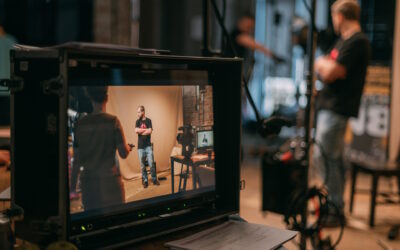Looking Beyond 2024
At Burning Stick Creative, we’re always on the lookout for what’s next, and artificial intelligence (AI) is undeniably at the top of our radar. As we inch closer to 2025, it’s clear that AI isn’t just a trend—it’s a game-changer. But let’s skip the fluff and dive into how AI is transforming digital marketing in ways you might not expect.
Hyper-Personalization: Your New Best Friend
Remember when “personalized” meant using your name in an email subject line? That’s so 2010… Enter AI-powered hyper-personalization! Imagine your marketing strategy being as intuitive as your best friend—knowing what your audience wants before they even know it themselves. AI algorithms analyze browsing behavior, purchase history, and even social media activity to help digital marketers create more highly targeted content than ever before.
Chatbots That Actually Chat
Gone are the days of stilted, robotic responses from chatbots! AI-driven chatbots are evolving into conversationalists that can handle complex queries with ease, and even add a touch of humor if needed. They’re not just solving problems—they’re engaging, entertaining, and enhancing the user experience. So, don’t be surprised if your next chatbot seems like it has a personality all its own…just be careful not to offend our new computerized overlords in preparation for the inevitable robo-pocalypse…
Predictive Analytics: The Future is Now
Predictions are no longer just for mystics! AI tools are getting better and better at forecasting trends and customer behaviors, so digital marketers can anticipate what the audience will want next and tailor campaigns accordingly. It’s like having a sneak peek into the future, giving you the upper hand in creating timely and relevant strategies for your target audience.
AI-Generated Content: Creativity Meets Efficiency
AI can now whip up blog posts, social media captions, and even ad copy with impressive speed and accuracy. While we’d never suggest replacing your creative team with robots, AI can certainly take on some of the heavy lifting in routine content creation. This frees up your human talent to focus on the big ideas and innovative strategies that make your brand shine and stand out from the competition.

AI helps you grow
Visual Recognition: Beyond Filters
AI isn’t just for text; it’s revolutionizing visual content too. With advancements in visual recognition, AI can analyze and categorize images with incredible precision. There are different types of visual recognition, but the most commonly utilized are:
- Image Classification: identifying what an image contains by categorizing it into predefined classes. For example, AI can recognize and label an image as “cat,” “dog,” or “car.”
- Object Detection: involves locating and identifying objects within an image. It can pinpoint where objects are and can draw bounding boxes around them. This is useful for applications like self-driving cars, where identifying and tracking multiple objects on the road is crucial.
- Image Segmentation: dividing an image into segments or regions based on certain criteria, often to understand the image at a more granular level. For instance, in medical imaging, segmentation can help highlight specific areas of interest, such as tumors.
- Facial Recognition: identifies and verifies individual faces. It’s used in security systems, social media tagging, and personalized customer experiences.
- Feature Extraction: identifying and extracting specific features from images, such as edges, textures, and shapes, which are then used to analyze and interpret the content.
- Pattern Recognition: the use of algorithms to recognize patterns and anomalies in visual data. This can be applied in various fields, from quality control in manufacturing to diagnosing medical conditions.
Visual recognition relies on deep learning models, most commonly convolutional neural networks (CNNs), which are designed to process and analyze visual data with remarkable accuracy. These models learn from vast amounts of labeled data and can generalize from the patterns they detect, improving performance over time. This means better image tagging, more effective ad targeting, and even the ability to gauge brand sentiment through visual content!
NOTE: This category of AI programming does not include AI-generated imagery. AI-generated image programs can infringe on the copyrighted work of artists and designers, which has significant downsides other than just wonky fingers. While AI can generate stunning visuals quickly, we’re concerned about the devaluation of human creativity and the loss of personal touch in design. Designers and artists often bring unique perspectives, emotions, and cultural contexts to their work that AI simply cannot replicate. The reliance on AI for visual creation may lead to a homogenization of design, where originality, creativity, and innovation take a backseat to efficiency.
Balancing the use of AI with human creativity is crucial to maintaining the richness and diversity of marketing in an increasingly automated world!
Ethical AI: The New Frontier
As artificial intelligence becomes more integrated into digital marketing, ethical considerations are taking center stage. How do we balance innovation with privacy? How do we ensure these programs are used responsibly? How is consumer data being collected, stored, and used with AI? Can AI perpetuate or amplify biases present in the data they are trained on? These are important questions, and since these answers are still unclear, we’ll need to learn and adapt as we move forward into the future of marketing with AI.
As we look beyond 2024, it’s clear that artificial intelligence will continue to reshape the digital marketing landscape in exciting and unexpected ways. From hyper-personalization to visual recognition and automation, the future is full of possibilities. So, buckle up and get ready to embrace the AI revolution—your marketing strategy will thank you!
Stay tuned to Burning Stick Creative for more insights on how AI and other emerging technologies are changing the game. Until next time, keep creating, keep innovating, and keep pushing the boundaries of what’s possible!





